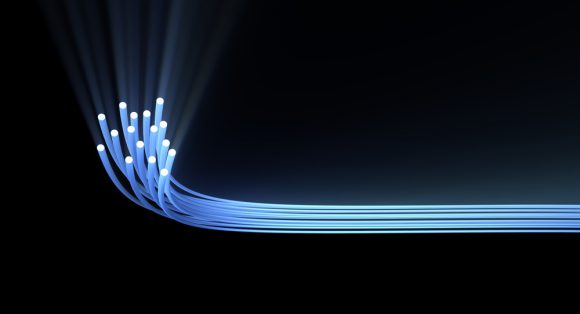Many businesses are turning to fiber-optic connectivity because it is cost-effective, scalable, and agile. Although the United States has been a leader in the development of the internet and related technologies, many parts of the country still lack access to fiber-based high-speed internet. In the absence of a nationwide fiber-optic network, organizations are turning to regional and local fiber-optic providers like FirstLight to fill their need for broadband business communication.
What Are Fiber Optics?
Fiber-optic cable is made up of hundreds of strands of glass, each no thicker  than a strand of human hair. Data is converted into laser-generated light pulses that are transmitted over the fiber-optic cable. Once the data reaches its destination, it’s converted from light pulses back into ones and zeros.
than a strand of human hair. Data is converted into laser-generated light pulses that are transmitted over the fiber-optic cable. Once the data reaches its destination, it’s converted from light pulses back into ones and zeros.
Fiber Optics: A Brief History
Fiber optics have been used in communication systems as far back as the 1790s. It was in that decade that the French inventor, Claude Chappe, designed the optical semaphore telegraph. Nearly 100 years later, Alexander Graham Bell received a patent for his Photophone, an optical telephone system. However, his earlier invention, the telephone, was more practical, so the Photophone faded into obscurity.
In the 1920s, Clarence W Hansell and John Logie Baird developed and patented the concept of transmitting images by way of transparent rods or hollow pipes. This innovation would pave the way for modern fiber-optic cable networks.
By the 1950s, two European scientists had published papers on fiber-cable image transmission. The British scientist, Harold H. Hopkins, also developed the crucial component of coating (or cladding) cables. Cladding the cables reduces interference between cable fibers and improves transmission quality. Without coating, optic fibers refract to create distortion and cross-talk.
Further fiber optic transmission innovations in the 1960s refined the technology enough for use in medical imaging devices, but not enough for long-distance communication transmission. A more refined and pure form of glass was needed to prevent light loss and make long-distance communications a reality.
In the 1970s, researchers at Corning Glass developed fiber-optic wire capable of carrying 65,000× more information than copper wire. These new optical fibers were derived from fused silica, a pure material with a low refractive index and high melting point. This breakthrough ushered in the age of fiber-optic cable. By spring 1977, General Telephone and Electrics had tested and deployed the first fiber-optic telephone system in Long Beach, California.
The Advantages of Fiber Optics for Communication
Fiber optics are preferable for business communication because they have several advantages over conventional copper wire. Here are just a few of the advantages of fiber-optic cable for communication:
Scalable
Fiber has a virtually limitless ability to scale bandwidth to continue to meet your organization’s bandwidth needs. The only limiting factor is the electronics used to ‘light’ the fiber. In comparison, copper and coax networks do not have the same level of scalability as fiber. What that means to you is that with fiber, you have a network connection that ensures you have an infrastructure that will continue to grow with your business.
Signal Quality
Electrical signals in copper wires can interfere with one another. Copper can also be susceptible to weather which creates interference and negatively impacts performance. With the innovation and perfection of cladding fiber-optic strands, interference is a non-issue, giving fiber-optic customers high-quality communications and streaming.
Efficient
Optical fibers have low rates of data loss which means that low-voltage transmitters can be used.
Agile
Fiber optics are flexible and use light for transmission, which means they can be used in a wide variety of settings and for many purposes. Digital cameras use fiber optics, for example.
Are you considering fiber-optic connectivity for your business? Speak with a fiber expert from FirstLight.





















